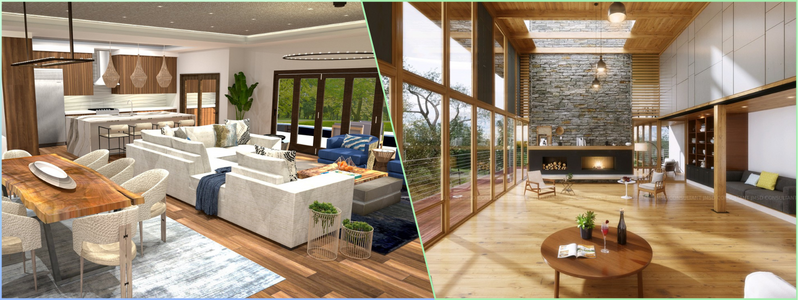What are millwork drafting and design drawing rates and costs for companies and firms? Architectural woodwork products fabricated or manufactured in a mill are known as millwork. Since millwork is considered a design element of an architectural project, they need technical drawings. Some millwork components are mass-produced, while others are built to client specifications or individual projects. Only the latter is called architectural millwork, whereas the former is called stock millwork. +
By definition, architectural millwork is custom-made and not supposed to be interchangeable. Reusing the technical drawings for another project without changes is almost impossible as the dimensions wouldn’t fit. On the other hand, stock millwork doesn’t have to follow any strict/personalized design requirements. Design for manufacturing firms can use the same drawings multiple times for large-volume production.
Both categories may include any kind of woodwork, such as cabinetry, stair parts, sidelights, transoms, moldings, trims, doors, and windows, to name a few. The only difference lies in whether the product is mass-produced or custom-built. Quality millwork requires precision cuts, flawless finishes, and detailed textures that require millwork drafting and design drawings. That said, architectural millwork is at a higher level of complexity—considering the potential intricacies of the millwork design requirements—compared to the stock variety.
RELATED: Millwork drawings outsourcing by freelance contractors on Cad Crowd
For example, most mass-produced bookcases are square and rectangular and made of easily-sourced materials like particleboard or MDF (medium-density fiberboard). However, a client may need an oddly-shaped bookcase made of kingwood (or other exotic wood materials) with several different types of dovetail joints and Polyurethane oil varnish finishing. In most cases, architectural millwork drafting services calls for the accuracy of power tools and skillful manual craftmanship. Many modern woodwork shops have sophisticated, high-performance equipment to bring the most difficult material to the desired shape.
Combine these tools with professional woodworking, and you get an assurance of efficiency and quality. Regardless of how proficient the woodworkers are and how sophisticated the range of equipment is, the final product largely depends on the millwork drafting and design specifications. Professionals use the available tools to help shape the parts, assemble the components, create details, and finally build the product. For large products, for example, kitchen cabinets and staircases, the components are fabricated in a mill and assembled on the building site.
 Table of contents
Table of contents
Why professional architectural millwork drafting
Architects, contractors, and homeowners do not usually build the millwork themselves. They have millwork drafted and produced by professional woodworkers. At the same time, the woodworkers also need professionally made millwork drafting and design drawings to ensure flawlessness in the final product. There must be a correct fit between the product and the designated space in the building. Millwork drafting & drawing service experts can be hired by your company to ensure the millwork is flawless.
RELATED: What casework shop drawings are and why architectural design services use them
Millwork drafting services must provide a technical drawing that represents the intended millwork design. Professional woodworkers submit the drafts to designers or architects for approval. The drafts are detailed 2D documentation of specific parts or products for the designers to review. If the drafting offers insufficient details, the millwork drawings designer may approve an incorrect product. The product is unusable once the millwork is finished and the mistake becomes apparent. The entire task has to be redone from scratch.

To minimize the possibility of misjudgment during the review process, woodworkers ideally submit design drawings that consist of multiple views of the same millwork, as listed below.
- Millwork plan view: the millwork design drawing is presented from an aerial perspective. When developing a floor plan, the seemingly simple geometrical drawing can help the floor plan designer understand the object’s dimension (relative to other objects). Dimensions not explicitly visible in the drawing, such as thickness and ground clearance, are written as annotations; the same rule applies to other drafts displayed in different views.
RELATED: Freelance contractors offer architectural drafting & CAD design services on CAD Crowd
- Elevation: a 2D drawing of millwork seen from the front. For example, an elevation view of a door panel depicts the millwork as being observed by looking directly straight at the object. All sides (in case they noticeably have different designs) can be shown as elevation views. Even the back side, if it is meant to be a visible design element, should be conveyed in the draft.
- Cross-section: a complex woodwork product with multiple compartments or drawers (such as nightstands or cabinets) and crucial interior design elements requires a cross-section view. The cross-section drawing represents the object as if it has been cut in half vertically or horizontally. It describes the relationship between the inner components.
- Detail: in millwork drafting, detail drawings function like attachments, providing enlarged views of the otherwise small yet essential components. For example, a cabinet might use a small LED lighting that requires specially-designed housing beneath the shelving; a wardrobe with a concealed compartment at the bottom might need a specially-made locking mechanism or small hinges. Without detail drawings to highlight the components, the furniture CAD design professionals are left prone to making uninformed design decisions or approval. Not every millwork requires detailed views of small parts. It is only necessary when the typically-unseen small components demand non-standard fabrication methods.
- Isometric: the main purpose of isometric drawing is to provide a clear perspective on the millwork’s overall shape. A professionally-drawn isometric millwork drafting serves as more than just an illustration but an image of reference to describe the relationship between all sides of the product. An isometric drawing displays the product as a three-dimensional object. It doesn’t have to be photorealistic with colors and textures, but the image must be clear enough to depict the product’s general layout accurately.
RELATED: 3D House and floor plans rates & costs for drafting services companies
- Floor plan: woodworkers are generally required to provide a complete floor plan for an architectural project. As far as millwork drafting is concerned, a floor plan only needs to display the arrangement of the fabricated products. Every object must have dimensions to give a basic overview of interior design. A floor plan is drawn from a bird’s eye perspective. Interior designers can use floor plan drawings for further interior styling and development.
Depending on who runs the project, a millwork supplier may submit the drawings to an architect, a designer, or a contractor. While the millwork drawings are ideally as comprehensive as possible, the best practice is to include only the specification information mentioned in the project brief. Too much information can lead to confusion instead.
Details for architects or designers:
- The outer dimension of millwork products
- General visualization attached with basic specifications, such as dimension and material thickness
- Positioning and orientation of furniture pieces
- Detail drawings for non-standard design elements
The interior layout is the primary focus; therefore, millwork products’ orientation, arrangement, and joinery must be conveyed appropriately. Architectural design and drafting services prepare the drawing by first studying the conceptual floor plan.
RELATED: How architectural companies design 3D floor plans for residential home design
Details for contractors:
- Installation guide (or assembly instruction if the millwork must be assembled on site)
- Clearance and tolerances
- Detailed isometric drawings for parts alignment purposes
- Trims, assembly parts, and fixtures
A contractor oversees the onsite construction process and must ensure clients get what their money is worth. If an architect or chief designer focuses on the big picture, a contractor puts all the small pieces together to solve the puzzle.
Details for shop floor woodworkers:
- Individual part drawings in 3D exploded views
- Tooling profile and configuration
- Detail drawings of joinery
- Machine tolerances
- Isometric drawings of millwork products as a reference
The most comprehensive millwork design drawings belong in the woodworking shop. Regardless of the product, the shop floor woodworker needs clear documentation on how each part is made. To build a quality product, a woodworker needs a good understanding of the product’s appearance and the relationship between components. Millwork drawings may include markups that correspond to revisions based on onsite surveys or changes requested by clients. Some drafters provide BoM sheets for individual millwork products as well.
RELATED: Why you need to use 3D modeling services to create floor plans

Cost
Millwork drafting and design drawing services are priced per page or per hour. More views require more pages and work hours. A page of millwork drafting and design services typically consists of three separate drawings: a millwork plan view, an elevation view, and two cross-sections. They are drawn at a scale to fit a “D” size paper (24-inch x 34-inch, standard size for engineering design drawings). The rates vary from $30 per page for a one-person operation or freelancer to $250 per page for a drafting or shop drawing firm. The pricing structure makes more sense if the project requires many complex custom woodwork products.
The final cost is based on the number of sheets delivered, not an hourly rate. Some services only list the prices for the original submittal set, excluding the fees for revisions and as-built. Modifications are often priced hourly, up to $65/hour. The hourly rate also varies from one millwork drafter to the next. A freelance millwork drawings designer might be willing to take the job for as little as $20 per hour, but a firm with overhead and multiple drafters in the team can charge at least $100 per hour. An hourly rate is ideal for a small project with only a dozen or fewer millwork products required.
| Millwork drafting and design services: | ||
|---|---|---|
| Service description | Cost per page | Cost per hour |
| Millwork drafting and design services (one-person/freelancer) | $30 | $20 |
| Millwork drafting and design services (drafting/shop drawing firm) | $250 | $100 |
| Modifications (hourly rate) | – | Up to $65 |
Please note that the provided costs are approximate and vary depending on the complexity of the project, the experience of the drafter/designer, and the specific requirements of the millwork drawings. The cost per page typically applies to the original submittal set, while modifications may be priced separately hourly.
How Cad Crowd can help
When you have a project that requires custom millwork, let the talent at Cad Crowd take care of the drafting portion. Cad Crowd has many high-caliber designers and engineering design services available, so there’s sure to be at least one great fit to take care of your millwork drafting so that you can focus on other valuable aspects of the project. The millwork drawing experts at Cad Crowd are ready to guide you with their specialized experience and deliver outstanding work! Contact us for a free quote.
